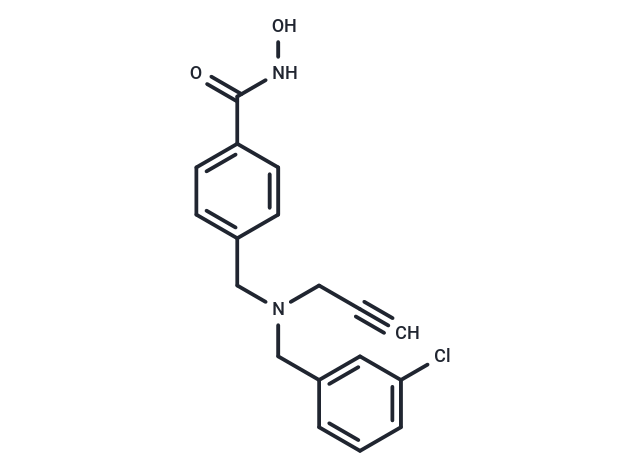Shopping Cart
Remove All Your shopping cart is currently empty
Your shopping cart is currently empty
HDAC1/MAO-B-IN-1 has the potential to be used in the Alzheimer's disease research. HDAC1/MAO-B-IN-1 is a potent and selective inhibitor of HDAC1/MAO-B that can cross the blood-brain barrier. The IC50 values of HDAC1/MAO-B-IN-1 for HDAC1 and MAO-B are 21.4 nM and 99.0 nM, respectively [1].

| Pack Size | Price | USA Warehouse | Global Warehouse | Quantity |
|---|---|---|---|---|
| 25 mg | $1,520 | 6-8 weeks | 6-8 weeks | |
| 50 mg | $1,980 | 6-8 weeks | 6-8 weeks | |
| 100 mg | $2,500 | 6-8 weeks | 6-8 weeks |
| Description | HDAC1/MAO-B-IN-1 has the potential to be used in the Alzheimer's disease research. HDAC1/MAO-B-IN-1 is a potent and selective inhibitor of HDAC1/MAO-B that can cross the blood-brain barrier. The IC50 values of HDAC1/MAO-B-IN-1 for HDAC1 and MAO-B are 21.4 nM and 99.0 nM, respectively [1]. |
| Targets&IC50 | MAO-B:99.0 nM, HDAC1:21.4 nM |
| In vitro | HDAC1/MAO-B-IN-1 (compound 1f) inhibits hMAO-B, hMAO-A, and hHDAC1 with IC50 values of 99.0 nM, 9923.0 nM, and 21.4 nM, respectively [1]. At 50 μM over 24 hours, it shows neuroprotective effects and reduces reactive oxygen species (ROS) production in PC12 cells, as confirmed by a Cell Viability Assay [1]. |
| In vivo | Administered intragastrically (i.g.) at 20 mg/kg, HDAC1/MAO-B-IN-1 demonstrates favorable permeability across the blood-brain barrier (BBB) [1]. When administered intraperitoneally (i.p.) at 15 mg/kg for 15 consecutive days, it enhances the learning and memory functionalities in ICR mice, both male (6-8 weeks old) and female (20-25 g) models [1]. |
| Molecular Weight | 328.79 |
| Formula | C18H17ClN2O2 |
| Cas No. | 2759855-37-1 |
| Smiles | C(N(CC1=CC(Cl)=CC=C1)CC#C)C2=CC=C(C(NO)=O)C=C2 |
| Storage | Powder: -20°C for 3 years | In solvent: -80°C for 1 year | Shipping with blue ice/Shipping at ambient temperature. |
| Size | Quantity | Unit Price | Amount | Operation |
|---|

Copyright © 2015-2026 TargetMol Chemicals Inc. All Rights Reserved.